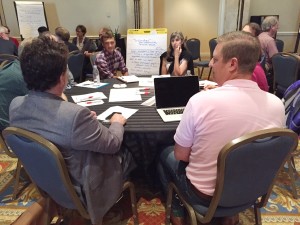A reflection on FFAR’s Phytobiome Convening Event
 Incredible challenges face the agricultural enterprise today: water scarcity, the need to reduce environmental impacts, a changing climate influencing plant productivity. The list goes on and on. As a result, our community must think creatively about how we do more, faster, with less. We have many tools in our toolbox: plant breeding for adaptive traits, integrated pest management, precision agriculture and new inputs that leave smaller footprints, to name a few. But we’re always on the lookout for knowledge and technologies to accelerate progress and perhaps shift the paradigm of how we look at food production.
Incredible challenges face the agricultural enterprise today: water scarcity, the need to reduce environmental impacts, a changing climate influencing plant productivity. The list goes on and on. As a result, our community must think creatively about how we do more, faster, with less. We have many tools in our toolbox: plant breeding for adaptive traits, integrated pest management, precision agriculture and new inputs that leave smaller footprints, to name a few. But we’re always on the lookout for knowledge and technologies to accelerate progress and perhaps shift the paradigm of how we look at food production.
The movement to enhance crop production by understanding and manipulating the phytobiome is one promising paradigm. The phytobiome consists of plants, their environment and their associated communities of organisms. We’ve
studied the impact of water and nutrients on crops for a long time and know much about how insects and plant diseases affect agricultural productivity. But recent advances in our capacity to characterize the broader plant microbiome, including millions (!) of microbes in soil, on leaf surfaces and in plant tissues, has opened new opportunities for understanding what makes our cropping systems tick and how to improve them. Integrating our developing understanding of the microbiome with our long history of research in agronomy, plant pathology, soil health and crop genetics will be a new avenue for meeting always evolving challenges. What if, for example, instead of a 15-year breeding program for new drought-resistant varieties, we could achieve a similar result by managing soil microbes to enhance water use efficiency? How about enhancing the community of beneficial plant-associated microbes through a change in when we plant or apply water or fertilizer, so these microbes enhance a crop’s natural resistance to pests and pathogens? Lots of opportunity here, so much so that the private sector sees “microbials” as a way of the future in enhancing crop production and are investing accordingly.
In order to take advantage of the emerging potential of the phytobiome, we need a deeper and richer understanding of the complex systems of plants and their biosphere, which are most often totally different when looking across crops and the environments in which they are grown. So here at FFAR we have asked the question, for this important area how should our foundation get involved in funding needed research in phytobiome? As a first step, FFAR and the American Phytopathological Society (APS) co-hosted the Phytobiomes Convening Event on July 29, with generous sponsorship from APS and The BioAg Alliance. Representatives from academia, industry, nonprofits and government gave lightning talks, participated in panels and worked in breakout groups to help FFAR prioritize phytobiomes research opportunities. Participants also identified areas of partnership in the pre-competitive space where FFAR might collaborate with co-sponsors to create a phytobiome funding opportunity.